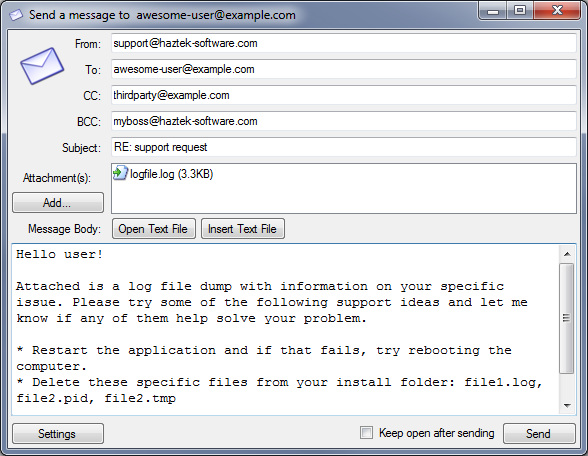

Messages that are sent by either internal senders or external senders. Messages that are sent by the specified mailboxes, mail users, mail contacts, or Microsoft 365 groups in the organization.įor more information about using Microsoft 365 groups with this condition, see the Addresses entry in the Property types section. If you set -Envelope, the sender will be user who sent original message.Ĭondition and exception parameters in Exchange Online PowerShell.If you set -Headers, the sender will be user generated Auto-Reply message.In the Auto-Reply scenario, sender is determined by checking the SenderAddressLocation. To learn more, see A transport rule doesn't match if user mailbox rules automatically forward messages In the automatic-forwarding scenario the sender address for forwarded mail is the original sender and not the forwarder. Header or envelope ( HeaderOrEnvelope) Examine senders in the message header and the message envelope. The sender's domain is ( SenderDomainIs).The sender address matches ( FromAddressMatchesPatterns).The sender address includes ( FromAddressContainsWords).The sender is a member of ( FromMemberOf).Note that message envelope searching is only available for the following conditions (and the corresponding exceptions): This is the default value.Įnvelope: Only examine senders from the message envelope (the MAIL FROM value that was used in the SMTP transmission, which is typically stored in the Return-Path field). Header: Only examine senders in the message headers ( From field). In PowerShell, the parameter is SenderAddressLocation.

Note that you might need to click More options to see this setting. In the EAC, in the Properties of this rule section, click Match sender address in message. Also, the names of some of the predicates that are returned by this cmdlet are different than the corresponding parameter names, and a predicate might require multiple parameters.įor conditions and exceptions that examine the sender's address, you can specify where rule looks for the sender's address. The settings and properties are the same in conditions and exceptions, so the output of the Get-TransportRulePredicate cmdlet doesn't list exceptions separately. The equivalent in PowerShell is to create a rule without specifying any condition parameters. If you select in the EAC, you can't specify any other conditions.
#Online message sender full#
The short names and full click path values are shown in the EAC column in the tables. Also, when you create new rules based on a template (a filtered list of scenarios), you can often select a short condition name instead of following the complete click path. Message sensitive information types, To and Cc values, size, and character setsĪfter you select a condition or exception in the Exchange admin center (EAC), the value that's ultimately shown in the Apply this rule if or Except if field is often different (shorter) than the click path value you selected. The property types are described in the Property types section. The tables in the following sections describe the conditions and exceptions that are available in mail flow rules in Exchange Online. Conditions and exceptions for mail flow rules in Exchange Online For example, the Any attachment has executable content condition simply looks for attachments in messages that have executable content.įor more information about mail flow rules in Exchange Online, including how multiple conditions/exceptions or multi-valued conditions/exceptions are handled, see Mail flow rules (transport rules) in Exchange Online. Some conditions or exceptions don't have any properties. For example, the A message header includes any of these words condition requires one property to specify the message header field, and a second property to specify the text to look for in the header field. For example, the The sender is condition requires the sender of the message.

Most conditions and exceptions have one property that requires one or more values. The only difference is conditions specify messages to include, while exceptions specify messages to exclude. Collectively, the conditions and exceptions in mail flow rules are also known as predicates, because for every condition, there's a corresponding exception that uses the exact same settings and syntax. For example, if the rule adds a disclaimer to messages, you can configure the rule to only apply to messages that contain specific words, messages sent by specific users, or to all messages except those sent by the members of a specific distribution group. Conditions and exceptions in mail flow rules (also known as transport rules) identify the messages that the rule is applied to or not applied to.


 0 kommentar(er)
0 kommentar(er)
